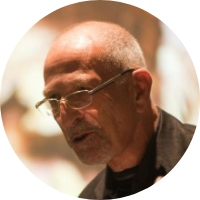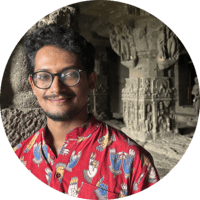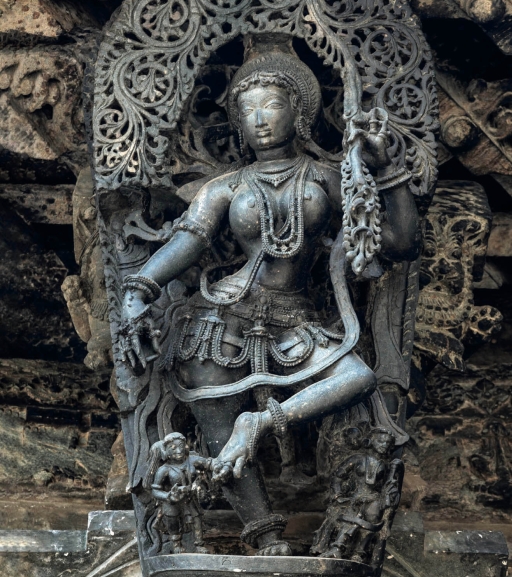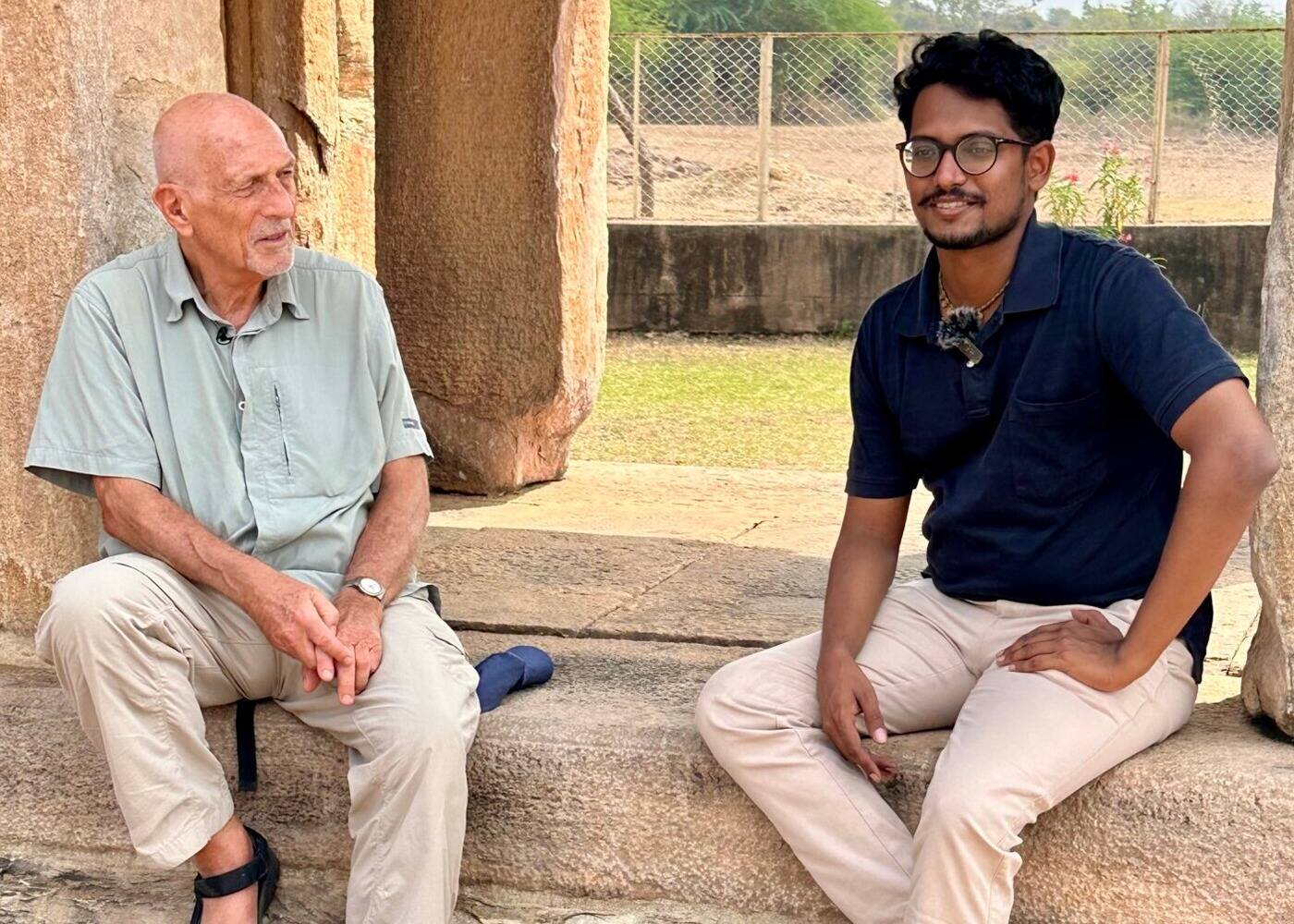The Origins and Evolution of Temple Architecture in South India
Dr George Michell in Conversation with Anirudh Kanisetti at Aihole
Follow George Michell and Anirudh Kanisetti on a fascinating and wide-ranging conversation on the origins, evolution, and patronage of early South Indian temples which took place at Aihole, during a tour of the Deccan sponsored by the Deccan Heritage Foundation.
Programme
January 2024
Introduction
Anirudh Kanisetti Hello, welcome to the session with the Deccan Heritage Foundation. I’m accompanying Dr. George Michell and a group of history enthusiasts as we’re exploring various Deccan sites. We are coming to you from the Ravana Phadi cave in Aihole, one of the great architectural and economic centers of the early Western Chalukyas also known as the Vatapi or Badami Chalukyas. And we’re going to be having a discussion over the next 20 minutes or so about various aspects of South India’s architectural history. So, let’s begin.
Dr. Michell, first, thank you so much for everything that you’ve told us in the last few days and for your decades of fantastic work. I must say I’m very humbled to be sitting next to one of my personal architectural historical heroes.
Origins of Stone Temple Architecture in South India
Anirudh Kanisetti The question I want to ask you is fundamental in terms of the origins of stone architecture in southern India. Very often, there’s a tendency to think of things as being of a Chalukya style or a Pallava style. So very often there’s a tendency to talk of buildings as Chalukya or Pallava, or of sculptures or sculptural motifs as Chalukya or Pallava. Just for context for listeners: the Chalukyas are here in the Deccan where we are, and the Pallavas are in India’s southeastern coast.
Do you think that using dynastic labels like this has a lot of utility in thinking about the way that architectural styles originated and were spread around? And really, what does the evidence, the built evidence, tell us about the origins of stone architecture – where it’s potentially disseminating from, or about the people who are building it?
George Michell Well, it’s a convenient, but by no means accurate, way of defining the type of architecture. So, we have the earliest stone Dravidian (South Indian) style temples here, and at Aihole, but to say that they are Chalukyan in style is already equating the style with the ruling people. We don’t know where the style originated, we just suddenly have in 634 CE this wonderful, fully evolved style, with all the elements there in a very primitive, rudimentary fashion.
We could say the Chalukyas invented it, and it’s a Chalukya style which then got exported down to the Pallavas. There was a lot of interaction, happy and not so happy, and therefore it’s a Chalukyan export into Pallava territory. But I think this would not be a helpful way of thinking. It’s a South Indian style, which first is manifested to us today here. Remember, we’re missing so much. We don’t know everything. We don’t have the brick architecture, which would have probably given us clues as to how this architecture evolved. All that is gone. So, we’re working with limited data. And we’re trying to link these dots, these individual bits of information, these monuments into some sort of narrative.
Anirudh Kanisetti I think an interesting way to think about it is that it’s a jigsaw puzzle. We know we have some pieces, but we don’t know how many pieces we’re missing. And we’re just trying to match together the pieces of the puzzle we do have, and that might not be an accurate representation of what is happening at all, because it doesn’t have to have been the case that stone architecture was inspiring stone architecture. It might have been brick architecture from different regions that was inspiring stone architecture and then going the other way around. And there are so many missing links, that it’s just impossible for us to get a full picture of how this fantastic architectural tradition evolved.
George Michell As scholars, we’re always trying to make stories. And if we are honest, we must put perhaps question marks and we must use a sort of a language which says this is the best reading that we can manage given the data that we have, which is incomplete. It is very interesting, that in the Tamil region, this pride in Chola tradition is very striking, as if everything has emerged from this part of India. But the archaeological evidence is that the earliest manifestations of these styles and some of these carvings are actually from the Deccan as we have it today. So, this, of course, doesn’t quite fit into the pattern that some people would prefer, but this is the evidence that we have at the moment.
Who Were the Architects, Sculptors and Masons Who Built the Early South Indian Temples
Anirudh Kanisetti I’m also curious about who were the people who were building these temples. You mentioned why empires would want to build in a particular style, why they would want their buildings to look a particular way. But does that also give us a sense of who the people are who are working on, and carving and constructing these buildings? In Vijayanagara, for example, when they are building the colossal gopurams of the Virupaksha temple, are they bringing in Tamil sculptors or are there local architects well-capable of replicating the same kinds of forms?
George Michell We have fragmentary evidence of some of these architects and guilds at Pattadakal. We have some inscriptions of the architects — they’re named, and they’re given honorific titles, which means they were given prestige. And one of them says, ‘built the South or from the South’. And people immediately jumped in said, oh, that means they come from the South, whatever the South means, and other people said, they built the South wall. So even interpreting is problematic.
But we have very little historical information about these guilds, these master masons, the great architecture Stapatis. We know that they were there, they must have been there, because these buildings and these rock-cut caves are not done randomly. They were planned extremely carefully.
You know, I think we have the idea that people just set off and did it – not at all. Everything had to be designed. We have no drawings; we have no models. But we imagine that such things did exist, that they knew what to do. The proportions were fixed, there was somebody in charge, saying this is the way to do it, not that way. We must do this. And there are, of course, little mistakes that happen when different groups meet and don’t quite agree on how to do things. This is the life of building the built environment.
It is created by people who do not lead lives that are recorded in the way of great figures in the political history of India. And this of course, is not specific to India. It’s true everywhere. Only today our architects are writing great books about who they are and what they think (not that we necessarily believe them), and then they build. So, this idea of showcasing the personal lives and thoughts of builders and architects – it’s a very modern thing.
How Was Temple Building Knowledge Disseminated
Anirudh Kanisetti Well, what can we guess about how these temples were planned out? What kind of geometries were at play, how did they arrive at these solutions? How do they know that a temple of a particular height would require a base of a particular size? How did they figure all this out and transmit this knowledge across generations?
George Michell Well, this obviously wasn’t done through written texts. We don’t have this, the Shastras don’t give us much practical information, they give theoretical information. But I think there were these traditions which were handed down verbally and through practice. I think this is true in many parts of the world. This is how these building traditions do go from one generation to the other. Now, when we lay out a temple of this size, we must have a basement of that type. If it goes to this height, it must have this proportion or that proportion. We can work backwards from the temples. So, this is something which scholarly investigation could pursue. You take the building, you analyze its geometry, you analyze the weight of the stones in it, and you know how much basement was required, what was done.
This suggests the great stone top of the Tanjore Temple, which as you may know, was always thought to be one great piece of stone, the capping piece. And actually, it’s not one piece. It’s two or three pieces, but there is a myth that it was one piece. There’s a whole literature on how they ever lifted it, but in fact, they didn’t lift it because it wasn’t one piece. So, legend gets in the way sometimes.
I think observation and study, meticulous technical study of these buildings, is required. Very little of this has been done for India, but it has been done for, let’s say, ancient Greek architecture, or Gothic architecture.
Who Commissioned Early South Indian Temples
Anirudh Kanisetti The other thing I wanted to ask, George, was in terms of who is commissioning these temples, the general tendency is to think of them primarily as royal projects. But was this always the case, or was patronage a more diverse act? Were more sections of society – were women, were people of non-royal castes and groups – building temples?
George Michell The problem is that the inscriptional evidence, the writing on stone, is often from the elite layers of society, that is the Kings, the Queens, maybe the chief ministers. So, we don’t know who commissioned. In Aihole, for example, there are so many small temples. Each one was obviously paid for, commissioned, by somebody under some circumstances, but we don’t have any information about that. We don’t know; we can imagine that all sorts of people did commission. We have very limited information. And it’s mostly for the top segments of the population because they could afford to record their gifts in stone, essentially.
The Role of Women as Patrons of South Indian Temples
Anirudh Kanisetti Interesting. I also believe that at Pattadakal we have somewhat clearer evidence of royal women making temples.
George Michell We have these famous sister queens, or the eldest sister who sponsored temples to commemorate victories of her husband. And according to your analysis, then sponsored a temple for her deceased younger sister. And what’s so interesting is that at Pattadakal we have three great temples in a row, by the father and by his daughters-in-law by marriage, and these three temples show the evolution of a style. You can suddenly see the movement of the architecture and this progression of style from simple to complicated, from smaller to bigger, from simpler to more elaborate. All these progressions are extremely well documented. And we have this impression that this is an incredibly inventive moment in the history of temple architecture in this part of India. So that the Virupaksha temple, the great temple – not the one at Hampi but the one at Pattadakal – was probably in its day the largest, most elaborate temple of its style anywhere in peninsular India.
Anirudh Kanisetti And it is built by a queen.
George Michell It was built by a queen.
Temple Architectural Evolution and Experimentation at Pattadakal
Anirudh Kanisetti And it’s also built in a complex that is, as you said, quite remarkable for its architectural experimentation. Were seeing not just what we would call a South Indian or Dravida style, but also temple spires that seem quite deliberately to be built in a North Indian, Nagara and Latina styles. Why do you think the Chalukyas were doing this?
George Michell Well, this is the question I want to ask you. We architectural historians have always wondered where did this North Indian, this so-called Latina, or Nagara style come from? What is it doing next to Dravida style in one place? It’s the only place in the peninsular India where you see this. So, how do you explain it?
And in your book, you drew attention to the marriage alliance between a Chalukya prince (I think his grandfather was king at the time), and two Kalachuri princesses. So, his grandfather sent him to the Kalachuris in the Ujjain area to marry these two girls, probably around 680-90 CE, something like that. And I think shortly afterwards this type of architecture from that area appears in South India.
Now, were the girls bringing with them architects or designers? Or was it the prince who said, ‘Look if we build in this style, we show that we have connections, we have command, we are somehow linked to this greater world of northern India. We are not subservient. We command this architecture’.
Anirudh Kanisetti Exactly.
George Michell And I think this is where architecture can play a visual role, it gives a visual statement of control. And I think that you can find this in the costumes, in all the artifacts of royal life of which architecture is one.
Anirudh Kanisetti Absolutely.
George Michell And do you think that’s a plausible way to start thinking?
Anirudh Kanisetti I absolutely agree.
George Michell Because I was blocked by this view, thinking that these girls had no connection with the Kalachuris from an earlier moment. But you pointed out that that marriage took place well before they built the temples.
Anirudh Kanisetti Exactly.
George Michell So that gives us a 680 CE sort of period – and we can refine that more – when these temples start to appear.
Anirudh Kanisetti That’s exactly right.
George Michell So it is a sort of a connection. It could be that what we need to do is find out what was going on in the Shilahara temple tradition at that time, and that’s something I don’t know. I haven’t done any work on this. I’m not sure we have the evidence there. And we perhaps can, with this project in view, start to reconstruct a narrative about this because I think it’s a really interesting topic.
Temples Built in Styles that Evoke Memories of Earlier Empires
Anirudh Kanisetti Yesterday as we were exploring Badami we happened to climb up this beautiful little cliffside just to the side of the fortifications there, where we saw the Malegetti Shivalaya, which you should be seeing on your screen right now. And George, you made this very interesting comment as we were looking at the sculptures there about how some of them seem to resemble those of the Gupta empire in Northern India. In fact, the term that you used was Neo-Gupta. And this really stuck with me because when you look at medieval Europe, you have what are very clearly revivals of older architectural styles because they have a particular kind of visual recall, a particular kind of symbolic importance.
So, what I’d like to understand is, to what extent did Indian kingdoms do this, and why do we think that the Chalukyas specifically would have wanted to potentially evoke memories of an older North Indian empire?
George Michell Well, we see this in the architecture and the sculptural decoration. I think Northern India had a longer established tradition of religious architecture in stone and with the sculptural adornments. When the Chalukyas get going, they develop their own styles, but they do not hesitate to make references to the styles of the North, even if these were already well established, and not of their period; but they learned about them through their campaigns and their connections with the North.
So, we have for instance at the doorways to the most elaborate Chalukya temples, Ganga and Yamuna, which are standard river goddess protective devices. These are borrowed from northern India, so you could say they are Neo-Gupta because that’s where we see them first. On the Malegetti Shivalaya we have two wonderful panels, which are in a very distinctive Gupta style, though it’s after the Gupta period. So, we have suggested this way of thinking about them as Neo-Gupta. And then of course, as you know, we have in later centuries in Vijayanagara, these wonderful temples built in what looks like a Chola style, but a revived Chola style. So, we could think of that as a Neo-Chola style. And in Europe, as you know, we have Neo Gothic, we have Neo Greek, Neo Classical, and these are not derogatory terms. They merely say that people have hearkened back to these traditions for their associations of grandeur, of scale, of culture. So, they are positive references.
Anirudh Kanisetti I think that’s a really interesting way of thinking about it. Because one of the oldest ideas that British colonial history writers had about ancient India was that Indians didn’t necessarily have a sense of history. The fact that they are building in revivals of older empires clearly indicates that there are some cultural memories of these polities that remain and there’s some cultural memories of what their architecture is meant to mean, what it signifies. It signifies lordship, control, power, cosmopolitanism. And I think it’s especially interesting that we’re talking about it here. Because as you pointed out, when we visited, some of the door guardians in this cave are believed to be wearing Central Asian costume.
George Michell Yes.
Anirudh Kanisetti I think that it’d be very interesting to also look at, for example, the Later Chalukyas, whose structures we’ll see at Sudi. They are built in the 11th 12th century, and once again, the Later Chalukyas seemed to build these temples in what was very obviously a Central Indian style. And I think it’s very possible to think of these as reflecting political claims, just as the Early Chalukya were building temples trying to imitate Gupta architecture, just as Vijayanagara imitates the Cholas. I think that there are layers and layers of potential meaning that emerge as we start to read different lines of evidence together: epigraphy, genealogy, alongside architecture and art history. So, thank you so much, Dr. Michell, for your time.
George Michell It’s a pleasure to be with a scholar who is 50 years younger than me, at the beginning, no, no longer at the beginning of his career, but I’m at the end of my career. And to think that we can still have a conversation and perhaps learn something from each other. Thank you.
Anirudh Kanisetti Thank you so much, George.
Speaker(s)

Dr George Michell
George Michell is a world authority on South Asian architecture, and a founder-trustee of the Deccan Heritage Foundation. He is amongst the most distinguished architectural scho... Read More

Anirudh Kanisetti
Anirudh Kanisetti is the author of Lords of the Deccan, a new history of medieval South India. He received the Sahitya Akademi Yuva Paraskar in 2023 and the Tata Literature Best... Read More


